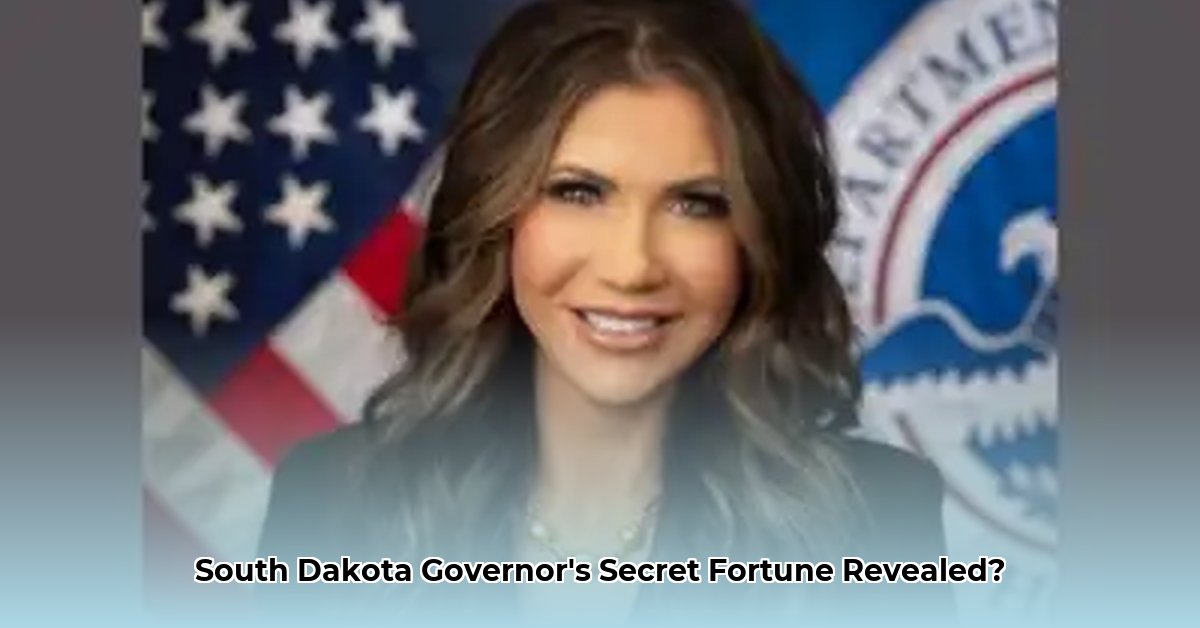
South Dakota Governor Kristi Noem's Net Worth: A Complex Calculation
Determining the precise net worth of South Dakota Governor Kristi Noem presents a significant challenge. Estimates generally range from $4.5 million to $5 million, but arriving at this figure requires navigating a complex web of assets and income streams. A substantial portion of her wealth is derived from the family's Racota Valley Ranch, a multi-generational agricultural operation. However, accurately assessing the ranch's current market value proves surprisingly difficult. Public records offer limited insight, and varying appraisals from different sources create significant discrepancies. This lack of readily available, verifiable data complicates any attempt to quantify the ranch's contribution to the Governor's overall net worth. How much is the ranch truly worth? That remains a key unanswered question. For more details, see Noem's Net Worth.
Beyond the ranch, Governor Noem's government salary, accumulated from her time in the U.S. House of Representatives and as governor, contributes significantly to her wealth. This income, being publicly accessible, provides a solid, verifiable component of her financial picture. However, other income streams remain less transparent. She reportedly owns a small insurance business and may receive royalties from book sales. The lack of detailed public financial disclosures concerning these ventures makes a comprehensive assessment difficult. Why the lack of transparency? This is a critical question that impacts the public's ability to assess potential conflicts of interest.
The absence of comprehensive financial disclosures raises significant concerns regarding transparency and accountability. This lack of openness creates an environment where potential conflicts of interest can arise, undermining public trust in the Governor's leadership. This situation underscores the need for greater transparency in the financial affairs of public officials and highlights the public's right to know how their elected officials manage their finances. How can we, the public, ensure greater transparency in the future?
The Racota Valley Ranch and COVID-19 Relief Funds: A Case Study in Transparency
The impact of COVID-19 relief funds on the Racota Valley Ranch, and consequently Governor Noem's net worth, adds another layer of complexity to this financial puzzle. The ranch received a substantial $500,000 grant from a state coronavirus relief program – a program that initially had a $100,000 cap. The subsequent increase of the grant cap to $500,000, and the timing of this increase relative to the application of the Noem family's business, has raised ethical questions regarding potential conflicts of interest. Was this an accidental benefit, or was it a deliberate policy decision?
Furthermore, a second round of applications was opened, further fueling debate. This event allowed for additional applications to be submitted and increases the likelihood that the Governor's ranch would receive a grant. The low percentage of applicants receiving the maximum grant—less than 4%— only adds to the public's skepticism. The situation highlights the need for stricter oversight of government funding programs and demonstrates the challenges of evaluating transparency surrounding applications submitted to government programs. This raises a critical question: Were these seemingly fortunate events merely coincidences, or do they indicate a pattern of favoritism?
Moreover, Arnold Bros. Water Management, a business connected to the Governor's brothers, also received over $100,000 from the same program. This additional funding further complicates the assessment of the impact of COVID relief funds on the Noem family's financial holdings. The cumulative effect of these grants presents a compelling argument for stricter ethics regulations and more rigorous oversight mechanisms to prevent such instances from occurring again. What safeguards can be implemented to prevent similar situations in the future?
The lack of comprehensive and publicly available information regarding the details of applications and approval procedures hinders a complete understanding of the situation. This transparency deficit undermines public confidence and exacerbates concerns about potential conflicts of interest. The program itself distributed $288 million in total. However, the vast majority of applicants received a minimal fraction of the amount granted to the Noem family. This stark disparity adds another dimension to the controversy.
Improving Transparency and Accountability: A Path Forward
To ensure greater accountability and transparency in the future, several crucial steps are necessary:
- Strengthened Financial Disclosure Laws: South Dakota needs to revise its financial disclosure regulations to require more comprehensive and detailed reporting of assets and income sources.
- Independent Audits: Regular, independent audits of government programs are crucial for preventing the misuse of public funds and ensuring responsible resource allocation.
- Robust Enforcement Mechanisms: Effective penalties must be in place for violations of financial disclosure laws to hold public officials accountable.
- Enhanced Citizen Participation: Active citizen engagement is vital in demanding greater transparency and accountability from their elected officials.
The current situation surrounding Governor Noem's net worth highlights the importance of these measures. While a precise figure remains elusive due to limited transparency, the available data reveals a compelling need for regulatory improvements, oversight enhancements, and a strengthened commitment to public trust. Continued investigation and further disclosures are necessary to unravel the complexities and answer the crucial questions that remain.